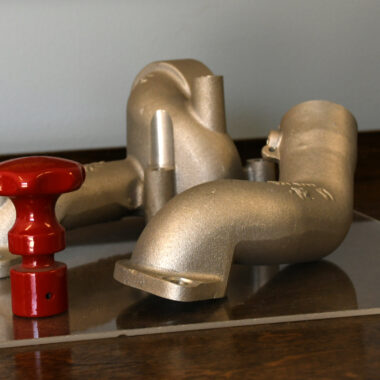Technology Let Loose: Advancements About Aluminum Casting
Wiki Article
Opening the Potential of Light Weight Aluminum Casting: Proven Strategies for Success
Aluminum spreading has actually long been recognized for its adaptability and prevalent applications across various markets. Join us as we check out the crucial elements that can push light weight aluminum spreading towards exceptional success in today's affordable market landscape.Advantages of Aluminum Casting
Light weight aluminum spreading supplies a multitude of advantages that make it a preferred choice in different industrial applications. Among the key benefits of light weight aluminum spreading is its light-weight nature, which adds to sustain effectiveness in sectors such as auto and aerospace. In addition, light weight aluminum is highly flexible, permitting intricate and complex shapes to be easily produced through casting procedures. This versatility in design is a considerable advantage for markets that call for parts with certain geometries.Furthermore, aluminum spreading supplies outstanding rust resistance, making it perfect for applications where direct exposure to extreme atmospheres is a concern. The product likewise exhibits excellent thermal conductivity, which is helpful for markets requiring warmth dissipation, such as electronics (about aluminum casting). Light weight aluminum is totally recyclable, lining up with the expanding emphasis on lasting methods in modern-day manufacturing.
Layout Considerations for Casting
The layout stage plays a crucial duty in the overall success of a light weight aluminum spreading task. One essential consideration is the choice of ideal geometries and attributes that promote the casting procedure.Additionally, considerations connected to parting lines, gating systems, and risers are vital to stop issues like porosity and shrinking. It is vital to maximize the design for efficient product use and decrease post-processing needs. Simulations and prototyping can be valuable tools in assessing and fine-tuning the spreading design before full-scale production.
Collaboration between design suppliers, designers, and factories is important to attend to any kind of prospective obstacles early in the design phase. By incorporating these considerations into the spreading style procedure, manufacturers can improve item top quality, reduce expenses, and inevitably open the full possibility of light weight aluminum casting.
Enhancing Casting Performance
Designing with an emphasis on enhancing material circulation and reducing issues is necessary when aiming to boost casting effectiveness in aluminum casting jobs. To attain this, making use of simulation software program can aid in determining prospective concerns prior to the spreading process begins. By imitating the flow of molten aluminum, designers can readjust gating and riser styles to ensure appropriate dental filling and solidification, eventually reducing the occurrence of defects such as porosity or shrinking.
Additionally, carrying out correct warm treatment procedures can enhance the total casting effectiveness. Heat treatment can assist boost the mechanical residential or commercial properties of the light weight aluminum spreading, making sure that the final part fulfills the required specifications. Additionally, utilizing automation and robotics in the casting procedure can streamline production, minimize hand-operated labor, and increase total efficiency.
In addition, continual tracking and high quality control throughout the spreading process are important for determining any variances and guaranteeing that the last products satisfy the desired standards. By carrying out these techniques, producers can boost casting performance, improve item top quality, and ultimately achieve better success in aluminum casting projects.
Top Quality Control in Aluminum Spreading

Reliable quality assurance methods play a critical function in making certain the precision and dependability of aluminum casting processes. Quality assurance measures in aluminum spreading include a variety of activities focused on maintaining certain criteria and recognizing inconsistencies that can endanger the last item. These practices begin with the careful option and assessment of raw materials to assure their quality and suitability for the spreading procedure. Monitoring and managing the criteria of the spreading process itself, such as air conditioning, stress, and temperature level rates, are crucial actions in maintaining consistency and honesty in the end products.
In enhancement to procedure control, high quality control in light weight aluminum casting entails strenuous screening and inspection procedures at various stages of production. By carrying out robust high quality control methods, aluminum casting facilities can deliver products that satisfy consumer expectations for performance, dependability, and top quality.
Optimizing Success
To accomplish ideal financial efficiency, Your Domain Name a comprehensive technique for taking full advantage of earnings within aluminum spreading procedures should be thoroughly created and carried out. One essential element of optimizing profitability in aluminum casting is enhancing manufacturing efficiency.
In addition, diversifying item offerings and exploring brand-new markets can assist broaden profits original site streams. Understanding consumer needs and market fads can assist strategic choices to maximize arising chances. Purchasing research and advancement to introduce items or procedures can additionally drive productivity through differentiation and consumer satisfaction.
Conclusion
In verdict, light weight aluminum casting supplies countless advantages in terms of layout versatility, cost-effectiveness, and durability. By thoroughly considering design factors to consider, boosting casting performance, implementing quality assurance actions, and making best use of earnings, suppliers can open the full potential of light weight aluminum casting. This functional and reputable process has confirmed to be an effective choice for a vast array of commercial applications.In addition, aluminum is highly malleable, permitting for intricate and complex forms to be conveniently generated through casting procedures.Efficient top quality control techniques play a pivotal role in making check sure the accuracy and reliability of aluminum spreading procedures.In addition to process control, quality control in aluminum casting entails extensive testing and examination procedures at different phases of manufacturing. By executing robust high quality control practices, aluminum casting centers can provide products that fulfill customer expectations for dependability, top quality, and performance.
By very carefully considering layout considerations, enhancing casting effectiveness, applying top quality control procedures, and making the most of profitability, producers can open the full possibility of light weight aluminum casting.
Report this wiki page